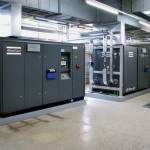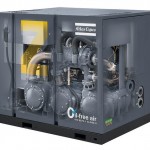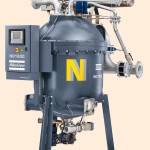Thanks to a number of sophisticated design features, continuous, high compressed air demand in the process industries can be met very reliably and even more energy-efficiently using Atlas Copco’s absolutely oil-free compressor ZH 350+. A compressed air station operates most efficiently if the ZH 350+ covers base-load demand and a variable speed drive compressor is used for compensate for demand fluctuations.
The author: Reimund Scherff Business Line Manager Oil-free Air, Atlas Copco Kompressoren und Drucklufttechnik
With immediate effect, large plants in the chemical industry and other sectors of industry can meet continuously high compressed air demand even more energy-efficiently. Atlas Copco has developed the oil-free turbo compressor ZH 350+ especially to meet the high base-load demand of plants of this type. The compressor is equipped with high-speed electric motors with a power installed of 350 kW and is best-suited for the widely used medium-pressure range from about 6 to 8 bar.
The typical application for the ZH 350+, which is up to 4 % more energy-efficient than the top-performing oil-free compressors offered by Atlas Copco to date, is in a multi-compressor station. To maximise the energy efficiency of the station, the base-load air demand should be covered by one or more turbo compressors. In addition, a variable speed drive compressor should be installed to accommodate for demand fluctuations. For example, the ZR series of screw compressors with variable speed drives (VSD) are suitable for this application. The rating of the compressor depends on the conditions of the individual project; in many cases a ZR 500 VSD with a 500 kW motor would be adequate.
A good control concept is essential
The control concept tailored to the requirements of the project defines load distribution between the individual compressors under all demand conditions so that the entire station can bring its energy efficiency advantages to bear. It is not so important whether a screw compressor or another type of compressor is used as whether the compressor is equipped with an (integrated) converter. In the opinion of Atlas Copco, every compressed air station should be equipped with (at least) one variable speed drive compressor for energy efficiency reasons. The ideal machine in each case de-pends on whether the operator is able to install a completely new station or is only interested in purchasing a replacement for an older compressor unit. The question of whether a smaller compressor is to be replaced by a larger unit to meet higher demands is also important.
In case of replacements and upgrading projects, it is recommended that Atlas Copco should carry out an Air-Scan to allow a precise assessment of the compressed air supply. The experts from Atlas Copco identify any weaknesses and leakages, check the actual load on the compressors currently installed, reveal the poor performers at the station and simulate the availability and energy savings that could be achieved by using various different new compressors on the basis of the most advanced compressors and the latest data available.
Design details
The Air-Scan report clearly indicates the savings in terms of power costs that could be achieved by installing a VSD compressor or the ZH 350+, for example. The low energy consumption of the ZH 350+ is mainly due to five design features. First, the three-stage design is based on innovative technology to achieve high thermodynamic efficiency and low power consumption. A three-stage design is widely recognised by experts in the field as the most efficient design for achieving compression between 7 and 11 bar with a turbo compressor. The three-stage turbo design results in average life cycle costs which are 3 % lower than those of an oil-free screw design and 18 % lower than those of two-stage turbo compressors.
Second, the ZH 350+ completely eliminates the gearbox, avoiding the transmission losses associated with a gearbox. Transmission losses can result in an energy efficiency reduction of up to 9 % in compressors in the 350 kW range.
Furthermore, the shafts of the compressor feature wear-free magnetic bearings; as a result, vibration is prevented and maintenance is not required. In addition, no bearing or transmission lubrication is required and the oil system is therefore entirely eliminated.
Third, the ZH 350+ has titanium impellers which are not only more reliable but also permit faster load-unload cycles. The speed gain results in reduced power losses at times of low air demand.
The two final design features have an impact on pressure drop and pressure losses. This compressor blows off upstream from the aftercooler, minimizing pressure losses in the event of falling air demand. Finally, the sizing of the coolers has been optimised, significantly reducing the pressure drop in these components. This design also allows a larger heat transfer area for heat exchangers.
Combination with waste heat recovery
In this context, it should be noted that waste heat recovery via heat exchangers is highly recommended for saving energy, especially in the process industry. In operation, compressors generate heat, more than 90 % of which can often be recovered in the form of hot water via a waste heat recovery system. For this purpose the cooling water, heated to 90 °C, is routed via heat exchangers and the heat energy recovered can be used for example for preheating boiler feedwater.
Especially at plants with continuous heat demand where compressors are operated continuously – for example in the chemical industry – the investment in a system of this type can be recouped very rapidly. The heat can be tapped from all compressors, including the variable speed drive compressor which will form part of a station equipped with at least one ZH turbo compressor. A variable speed drive compressor is always in operation (except in the case of a malfunction or a plant shut-down). As a result, it also generates heat continuously, which means that waste heat recovery from a compressor of this type is most effective.
Other energy savings
To return to the energy advantages of the ZH 350+, the combination of low air and transmission losses makes this turbo compressor about 4 % more energy-efficient than the hi-ghest-performance air compressors in the Atlas Copco range at the same operating conditions. Other energy savings are possible in combination with the ND and MD dryers that also made their debut at Hanover Fair in April 2011. These dryers feature low energy consumption and are therefore the ideal choice for users keen to minimise the environmental impact of their production facilities.
The MD 2000 dryers reach discharge dew points as low as -25 °C. In other words, the moisture still contained in the compressed air will not condense above this temperature under any circumstances. As a result, these units are suitable for more demanding applications than the usual refrigeration-type dryers, which are designed for dew points of 3 °C. The MD dryer extends the range of adsorption dryers, previously offered by Atlas Copco with oil-free screw compressors (such as the ZR) to turbo compressors. The MD dryers do not result in any pressure loss, no refrigerant is required, there is no need for filtration and no electric power is used. The energy demand is low, at only 120 W.
Discharge dew points as low as -40 °C
Atlas Copco adsorption dryers are so energy-efficient because they use the heat of compression of the compressors for regeneration. Adsorption dryers actively remove moisture from the compressed air using an adsorbent. As soon as this material is saturated, it can no longer adsorb moisture and must be regenerated. In conventional systems, this is achieved using a second container, or „tower“ of the dryer; in the MD dryer, a partition inside the drum is used. While air is dried on one section of the unit, the adsorbent is being regenerated in the other section.
The ND adsorption dryers, which are designed for even lower dew points, down to -40 °C, also operate in an energy-saving way. For example, the ND 1800, in combination with ZR screw compressors saves up to 50 % of the entire life cycle costs compared with conventional adsorption dryers. MD and ND dryers only use about 5 % of the absorbent required by conventional adsorption dryers,.
By the way, the ZH 350+ was certified by the independent TÜV inspection agency as Class 0 in accordance with ISO 8573-0 on 24 March 2011.
Online-Info: www.cpp-net.com/2211421
Share:












